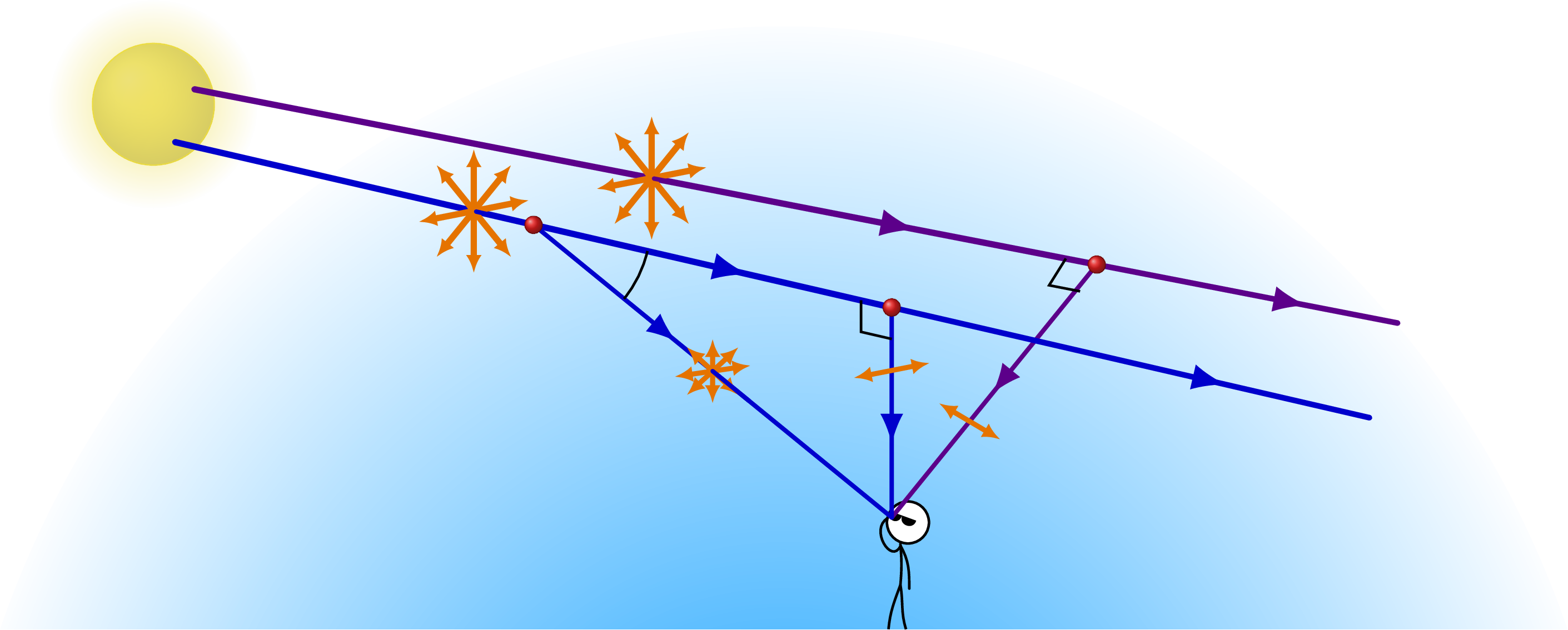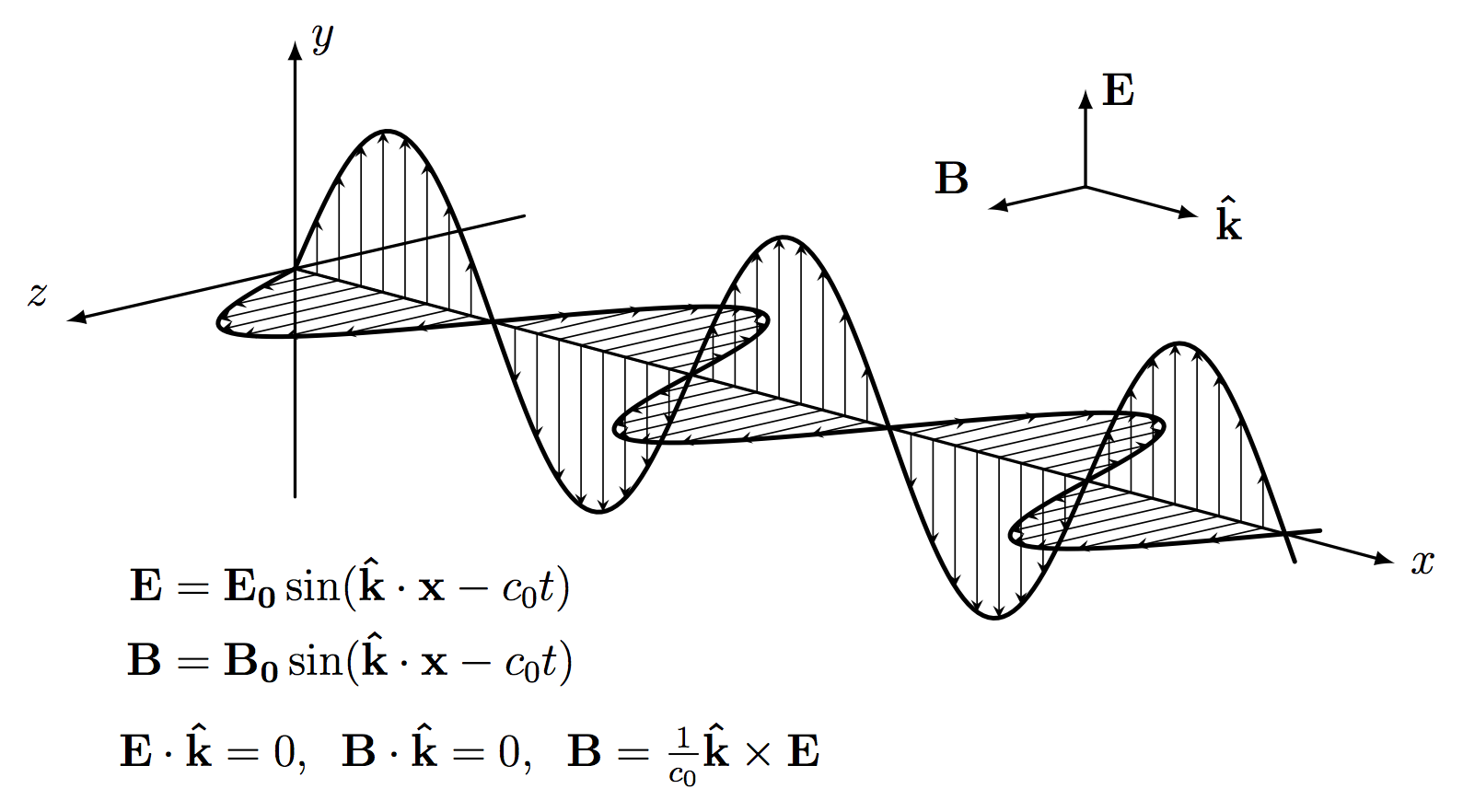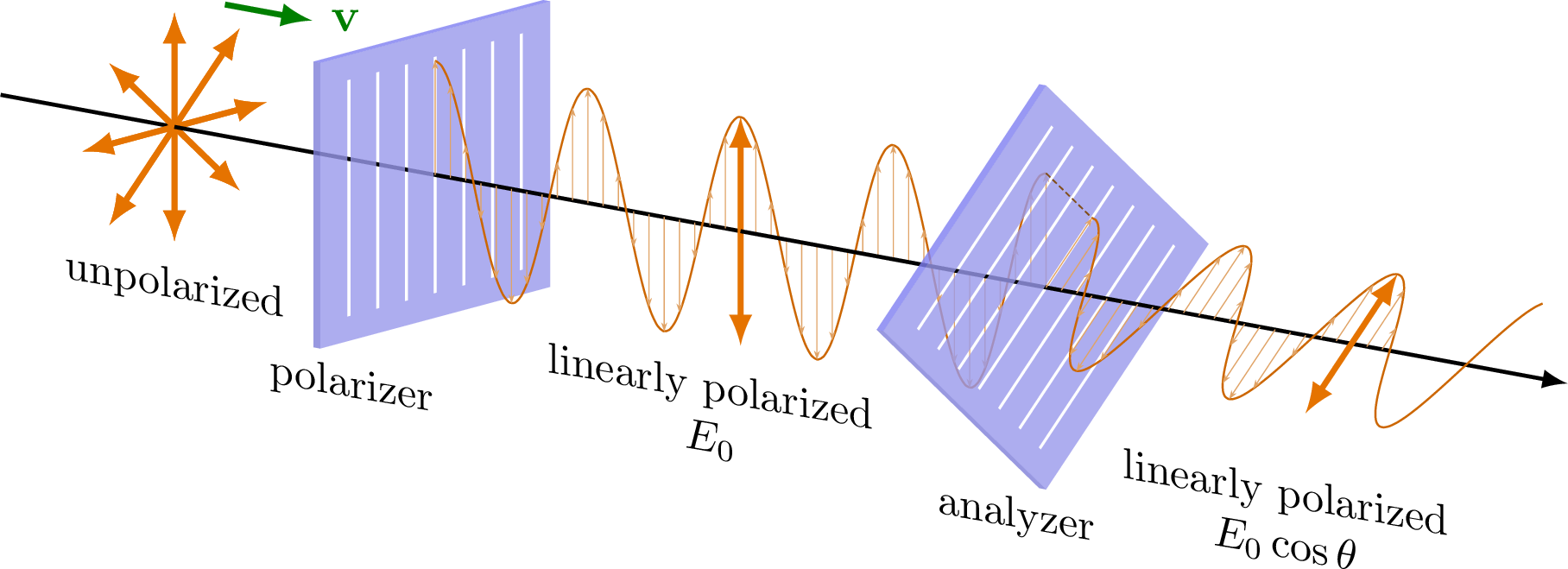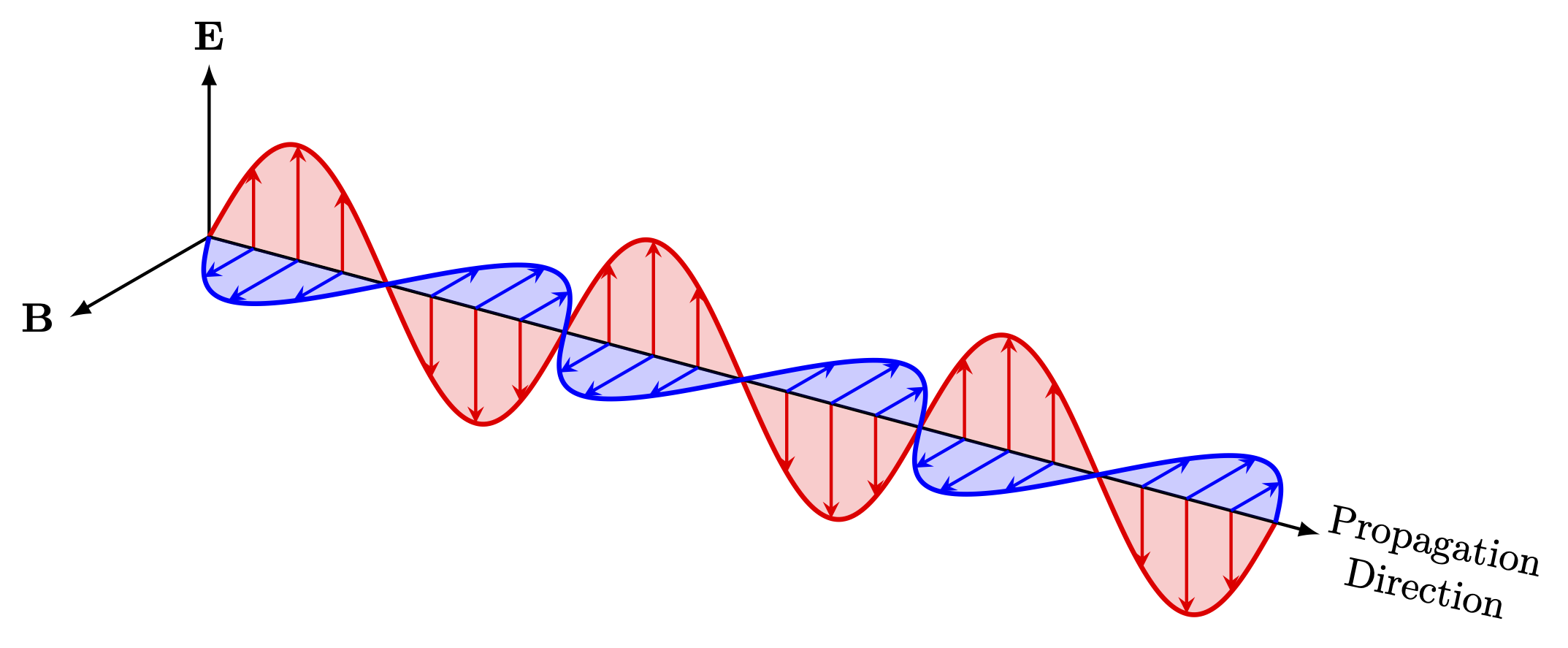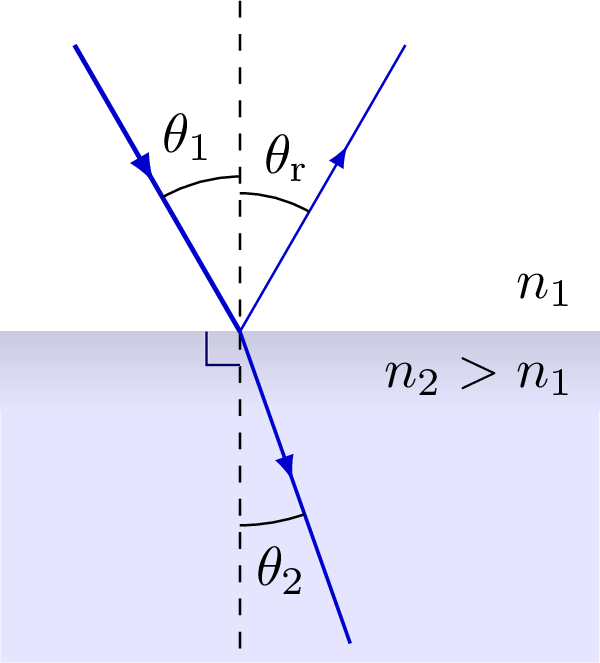Polarization by scattering, and polarization of sunlight in the blue sky.
For more related figures, please see the Optics category.
Edit and compile if you like:
% Author: Izaak Neutelings (May 2020)
% Inspiration: https://tex.stackexchange.com/questions/285578/how-to-draw-parallelepiped-and-cube-with-latex/288101#288101
\documentclass[border=3pt,tikz]{standalone}
\usetikzlibrary{arrows,arrows.meta}
\usetikzlibrary{calc}
\usetikzlibrary{decorations.markings}
\usetikzlibrary{angles,quotes} % for pic (angle labels)
\usetikzlibrary{fadings}
\tikzset{>=latex} % for LaTeX arrow head
\usetikzlibrary{3d}
\colorlet{myblue}{blue!80!black}
\colorlet{mypurple}{blue!60!red!90!black}
\colorlet{myred}{red!70!black}
\colorlet{Ecol}{orange!90!black}
\tikzstyle{myarr}=[-{Latex[length=3,width=2]}]
\tikzstyle{Evec}=[Ecol,{Latex[length=2.8,width=2.5]}-{Latex[length=2.8,width=2.5]},line width=1]
\tikzset{
light beam/.style n args={2}{line width=#2,myblue,line cap=round,decoration={markings,
mark=at position #1 with {\arrow{latex}}},
postaction={decorate}},
light beam/.default={0.5}{1}
}
\tikzfading[name=fade out,
inner color=transparent!20,
outer color=transparent!100]
\tikzfading[name=strong fade out,
inner color=transparent!0,
outer color=transparent!99]
\tikzfading[name=atmosphere,
inner color=white,
outer color=black]
\newcommand\molecule[2]{
\node[ball color=red,circle,inner sep=#2] at (#1) {};
\node[very thin,draw=red!30!black,fill=red!60!black!70,circle,inner sep=#2,fill opacity=0.3] at (#1) {};
%\draw[ball color=red,canvas is zy plane at x=0] (0,0) circle(0.5);
}
\newcommand\rightAngle[4]{
\pgfmathanglebetweenpoints{\pgfpointanchor{#2}{center}}{\pgfpointanchor{#3}{center}}
\coordinate (tmpRA) at ($(#2)+(\pgfmathresult+45:#4)$);
\draw[white,line width=0.5] ($(#2)!(tmpRA)!(#1)$) -- (tmpRA) -- ($(#2)!(tmpRA)!(#3)$);
\draw[mypurple!70!black,line width=0.4] ($(#2)!(tmpRA)!(#1)$) -- (tmpRA) -- ($(#2)!(tmpRA)!(#3)$);
}
\begin{document}
% POLARIZATION by scattering
\begin{tikzpicture}[x=(15:0.5), y=(90:0.6), z=(-20:1.3)]
\def\A{1.0} % initial amplitude
\def\a{0.8} % scattered amplitude
\def\L{15} % length beam
\def\W{4} % width horizontal scattered beam
\def\H{3} % length horizontal scattered beam
\def\t{0.8} % thickness scattered beams
\coordinate (O) at (0,0,0); % start point
\coordinate (A) at (0,0,0.10*\L); % polarization before
\coordinate (M) at (0,0,0.55*\L); % molecule
\coordinate (B) at (0,0,0.95*\L); % polarization after
\coordinate (D) at (0,-0.7*\H,0.75*\L); % end point scattered down
\coordinate (C) at ($(M)!0.8!(D)$); % polarization on MD
\coordinate (L) at ($(M)+(-\W,0)$); % left scattering
\coordinate (T) at ($(M)+(0,\H)$); % top scattered
\coordinate (Z) at (0,0,\L); % end point
% BEAMS behind
\draw[light beam={0.5}{2.0}] (O) -- (M);
\begin{scope}[canvas is xz plane at y=0]
\rightAngle{O}{M}{L}{0.6}
\end{scope}
\begin{scope}[canvas is zy plane at x=0]
\rightAngle{O}{M}{T}{0.5}
\end{scope}
\draw[light beam={0.5}{\t},mypurple] (M)++(0.01*\L,0) --++ (\W,0); % scattered right
\draw[light beam={0.5}{\t},mypurple] (M)++(0,-0.012*\L) --++ (0,-\H); % scattered down
\draw[light beam={0.5}{\t},mypurple] (M)++(0.01*\L,0.01*\L) --++ (40:0.8*\W) coordinate (TR); % scattered up right
% MOLECULE
\molecule{M}{2.5}
% BEAMS in front
\draw[light beam={0.5}{\t}] (M)++(0,0,0.012*\L) -- (Z); % scattered foreward
\draw[light beam={0.5}{\t},mypurple] (M)++(-0.014*\L,0) -- (L); % scattered left
\draw[light beam={0.5}{\t},mypurple] (M)++(0,0.012*\L) -- (T); % scattered up
\draw[light beam={0.6}{\t}] ($(M)!0.05!(D)$) -- (D); % scattered foreward down
% POLARIZATION
\foreach \ang in {0,45,90,135}{
\draw[Evec] (A)++(\ang:\a) --++ (\ang-180:2*\a); % before
\draw[Evec] (B)++(\ang:\a) --++ (\ang-180:2*\a); % after
\draw[Evec] (C)++(\ang:{\a} and {0.6*\a}) --++ (\ang-180:{2*\a} and {1.2*\a}); % foreward down
}
\draw[line width=2.0,myblue,line cap=round] (A)++(0,0,0.002*\L) --++ (0,0,0.1*\L); % overlap
\draw[line width=\t,myblue,line cap=round] (B)++(0,0,0.002*\L) --++ (0,0,0.1*\L); % overlap
\draw[line width=\t,myblue,line cap=round] ($(C)!0.001!(D)$) -- ($(C)!0.9!(D)$); % overlap
\draw[Evec] (M)++(-\a, 0.85*\H) --++ (2*\a,0); % top
\draw[Evec] (M)++(-\a,-0.85*\H) coordinate (BP) --++ (2*\a,0); % bottom
\draw[Evec] (M)++( 0.85*\W,-\a) --++ (0,2*\a); % right
\draw[Evec] (M)++(-0.85*\W,-\a) --++ (0,2*\a); % left
\draw[Evec] ($(M)!0.8!(TR)$)++(130:\a) --++ (-50:2*\a); % scattered up right
% LABELS
\node[purple!30!black,below=3,left=0,align=center,scale=1.1]
at (L) {linearly\\[-2]polarized};
\node[purple!30!black,below=3,left=-1,align=center,scale=1.1]
at (BP) {linearly\\[-2]polarized};
\node[myblue!30!black,below=3,right=1,align=left,scale=1.1]
at (D) {partially\\[-2]polarized};
\draw pic["$\theta$"{scale=1.2},draw=black,angle radius=26,angle eccentricity=1.2]
{angle = D--M--Z};
\end{tikzpicture}
% POLARIZATION of sunlight
\begin{tikzpicture} %[x=(15:0.5), y=(90:0.6), z=(-20:2.2)]
\def\A{0.35} % initial amplitude
\def\a{0.24} % scattered amplitude
\def\L{7} % length beam
\def\H{3.0} % length horizontal scattered beam
\def\W{9} % width ground
\def\h{0.61} % person height
\def\w{0.1} % person width
\def\r{0.12} % person head radius
\def\T{1} % thickness scattered beams
\def\t{0.70} % thickness scattered beams
\def\f{0.9} % horizonatal/vertical radius ratio
\def\anga{-13} % angle beam 1
\def\angb{-11} % angle beam 2 (mostly parallel)
\coordinate (S) at (0,\H); % sun
\coordinate (O) at (0,0,0); % start point
\coordinate (O1) at ($(S)+(-60:0.25)$); % start point beam 1
\coordinate (O2) at ($(S)+( 20:0.25)$); % start point beam 2
\coordinate (Z1) at ($(O1)+(\anga:\L)$); % end point beam 1
\coordinate (Z2) at ($(O2)+(\angb:\L)$); % end point beam 2
\coordinate (M1) at ($(O1)!0.60!(Z1)$); % molecule 1
\coordinate (M2) at ($(O2)!0.75!(Z2)$); % molecule 2
\coordinate (M3) at ($(O1)!0.30!(Z1)$); % molecule 3
\coordinate (A1) at ($(O1)!0.25!(Z1)$); % polarization before
\coordinate (A2) at ($(O2)!0.38!(Z2)$); % polarization before
%\coordinate (D) at (0,-0.7*\H,0.75*\L); % end point scattered down
% SUN
\node[ball color=yellow,circle,inner sep=7] at (S) {};
\node[very thin,draw=yellow!90!black,fill=yellow!80!black!70,circle,inner sep=7,fill opacity=0.8] at (S) {};
\node[fill=yellow!90!black!80,path fading=fade out,circle,inner sep=12] at (S) {};
% ATMOSPHERE
\begin{scope}[shift={(0.4*\W,0)}]
\clip (-0.51*\W,0) rectangle (0.51*\W,1.25*\H);
%\fill[blue!10!black] (-0.8*\W,0) rectangle (0.8*\W,1.25*\H);
%\fill[inner color=blue!80!cyan!40,outer color=blue!10!black] (0,-0.9*\H) circle(3*\H);
\fill[blue!40!cyan,path fading=strong fade out] (0,-0.65*\H) ellipse({1.6*\H} and {1.8*\H});
%\fill[blue!50!cyan,path fading=atmosphere] (0,-1.0*\H) circle(5*\H);
\end{scope}
% PERSON
\begin{scope}[shift={(0.607*\L,0)}]
\draw[thin,fill=white] (0.1*\h,\h) circle (\r) coordinate (H);
\draw[thin] % neck (N) -> shoulders (SH) -> pelvis (P)
(H)++(-110:\r) coordinate (N) --++ (-100:0.02*\h) coordinate (SH)
to[out=-85,in=85]++ (0,-0.38*\h) coordinate (P);
\draw[thin,line cap=round] (SH)++(-85:0.015*\h) to[out=-115,in=-150,looseness=1.8]++ (-0.12*\h,0.26*\h); % hand up
\draw[thin,line cap=round] (SH)++(-85:0.015*\h) to[out=-60,in=90]++ (0.5*\w,-0.4*\h); % hand down
\draw[thin] (P) to[out=-110,in=85] (-0.5*\w,0);
\draw[thin] (P) to[out=-80,in=108] ( 0.5*\w,0);
%\draw[draw=blue!80!black,fill=black,line width=0.1,rotate=-15]
\fill[black,rotate=-20] % sun glasses
(H)++(170:\r) to[out=-90,in=-90,looseness=1.9]++ (0:0.6*\r) --++ (0:0.02*\r)
to[out=-90,in=-90,looseness=1.6]++ (0:0.7*\r) --++ (90:0.04*\r) --++ (180:1.32*\r) -- cycle;
\end{scope}
% BEAMS
\draw[light beam={0.80}{\T},mypurple] (O2) -- (M2);
\draw[light beam={0.70}{0.9*\T},mypurple] (M2) -- (Z2);
\coordinate (F) at ($(M1)+(0,-0.4*\H)$); % face
\draw[light beam={0.51}{\t},mypurple] (M2) -- (F); % scatter down 2
\draw[light beam={0.80}{\T}] (O1) -- (M1);
\draw[light beam={0.70}{0.9*\T}] (M1) -- (Z1);
\draw[light beam={0.65}{\t}] (M1) -- (F); % scatter down 1
\draw[light beam={0.40}{\t}] (M3) -- (F); % scatter forward 1
\coordinate (B1) at ($(M1)!0.30!(F)$); % scattering down 1
\coordinate (B2) at ($(M2)!0.62!(F)$); % scattering down 2
\coordinate (B3) at ($(M3)!0.50!(F)$); % polarization after, partial
% POLARIZATION
\foreach \ang in {10,48,90,132}{
\draw[Evec] (A1)++(\ang:{\f*\A} and {\A}) --++ (\ang-180:{2*\f*\A} and {2*\A});
\draw[Evec] (A2)++(\ang:{\f*\A} and {\A}) --++ (\ang-180:{2*\f*\A} and {2*\A});
\draw[Evec,thick]
(B3)++(\ang:{\f*\a} and {0.75*\a}) --++ (\ang-180:{2*\f*\a} and {1.5*\a}); % partial
}
\draw[line width=\t,myblue,line cap=round] (A1)++(\anga:0.002*\L) --++ (\anga:0.1*\L); % overlap
\draw[line width=\t,mypurple,line cap=round] (A2)++(\angb:0.002*\L) --++ (\angb:0.1*\L); % overlap
\draw[line width=\t,myblue,line cap=round] (B3) -- ($(B3)!0.2!(F)$); % overlap
\draw[Evec,thick] (B1)++(10:{\f*\a} and {\a}) --++ (-170:{2*\f*\a} and {2*\a});
\draw[Evec,thick] (B2)++(-28:{0.9*\f*\a} and {0.9*\a}) --++ (152:{1.8*\f*\a} and {1.8*\a});
% MOLECULES
\molecule{M1}{1.0}
\molecule{M2}{1.0}
\molecule{M3}{1.0}
% ANGLES
\draw (M1)++(\anga+180:0.18) --++ (0,-0.18) --++ (\anga:0.18);
%\pgfmathanglebetweenpoints{\pgfpointanchor{M2}{center}}{\pgfpointanchor{F}{center}}
\draw (M2)++(\angb+180:0.18) --++ (-122:0.18) --++ (\angb:0.18);
\draw pic[draw=black,angle radius=19,angle eccentricity=1.2] %"$\theta$"{scale=1.2},
{angle = F--M3--Z1};
\end{tikzpicture}
\end{document}Click to download: optics_scattering.tex • optics_scattering.pdf
Open in Overleaf: optics_scattering.tex



